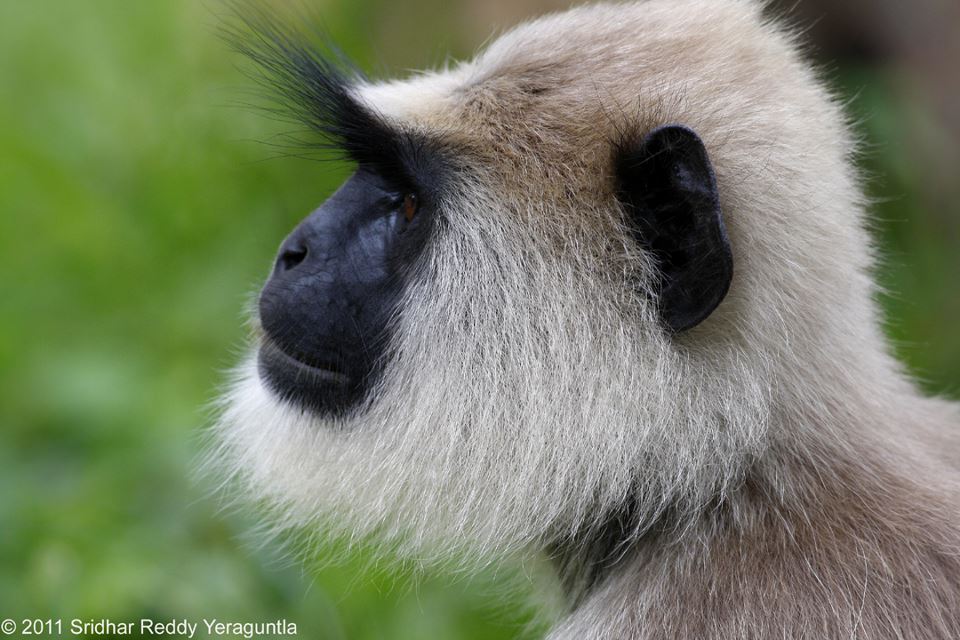To participate and share your images, please join Bush Warriors Photo of the Day Contest group on Facebook, which you can access by clicking here (http://www.facebook.com/
Photo Credit: Sridhar Reddy Yeraguntla
- Order: Primates
- Family: Cercopithecidae
- Subfamily: Colobinae
- Genus: Semnopithecus
- Species: Simia entellus
Grey Langurs are a genus of Old World monkeys once thought to be a single species. Seven distinct species are now recognised, and are widespread throughout the south of Asia. They range from Kashmir in north India and the Nepalese, Bhutanese, and Tibetan Himalayas, east to Bangladesh and west to Pakistan’s Indus Valley. They may also occur in Afghanistan. The most northerly species are generally larger and heavier than the southern Langurs, and they walk with their tails pointing forward, while southern Langurs point their tails backwards. Grey Langurs, with their black hands and face, are also known as Hanuman Langurs after the monkey-god, and so are considered sacred in the Hindu religion. They are large and fairly terrestrial, inhabiting forest, open lightly wooded habitats, and urban areas on the Indian subcontinent. They are the most widespread Langurs of south Asia.
Grey Langurs are largely gray (obviously), with a black face and ears. The species may vary tremendously in the darkness of hands and feet, and the overall color and presence or absence of a crest. There are also significant variations in the size of the Langur depending on the species, but the head-and-body length of males is typically gets up to 30 in (75 cm) and 26 in (65 cm) for females. The average weight is 40 lb (18 kg) for males and 24 lb (11 kg) for females, but the heaviest Grey Langur ever recorded was found in Nepal, and weighed in at 58 lb (26.5kg)! Langurs mostly walk on all fours, and spend about half their time on and the ground and the other half up in the trees. Langurs can leap 12-15 ft ( 3.7-4.6 m ) horizontally and 35-40 ft (10.7-12.2 m) downward.
Gray Langurs can adapt to a variety of habitats. They inhabit arid spaces such as deserts, dry open plains, dry deciduous forests, but also tropical and subtropical evergreen rainforests, moist deciduous forest, broadleaf forest, subtropical pine forest, riverine forest, open park woods, mountain foothills, mountain forests, Himalayan oak-coniferous forests, temperate coniferous forest, sub-alpine forest, grasslands, meadows, scrub, scrub forests, and mixed grasslands. They can live at altitudes up to 13,000 ft (4,000 m), including areas that receive snowfall in the winter. They can even adapt well to human settlements, and are found in villages, towns, residential areas, tourist areas, temple grounds, orchards and cultivated areas. They are also found in densely populated cities like Jodhpur, which has over a million inhabitants.
Despite their great adaptability, Grey Langurs are in trouble, largely due to habitat loss. While many populations of Gray Langurs are stable, in some areas they are declining, and both the Black-Footed Gray Langur and Kashmir Gray Langur are considered threatened; the Kashmir Grey Langur is the rarest species of Gray Langur, with less than 250 mature individuals remaining. Langurs are most prevalent in India, where their numbers hoover around 300,000. India has laws prohibiting the capture or killing of Langurs, but these laws are difficult because many people don’t know they are protected. The natural habitats of Gray Langurs is threatened by encroachment and plantation, as well as slash-and-burn agriculture. Since they often live in populated areas, Langurs can be found near roads, and are often the victims of automobile accidents. Though they are considered sacred in the Hindu religion, some groups from different religions hunt the Langurs for medicinal purposes, and to create amulets.
To share your wildlife photos with the Bush Warriors community, go to our Photo of the Day Contest Facebook page and upload your shots today! All you need to do is upload them onto the wall. Please do not create new albums, but rather upload each photo on its own. Click here to view ALL of our Photo of the Day winners and for more information on the Bush Warriors Photo of the Day Contest. Enjoy the beauty of nature, just as it was intended to be!
The Bush Warriors Photo of The Day Contest is brought to you in partnership with Creative Visions Foundation. Inspired by the life of Dan Eldon, a young Reuters photojournalist killed in Somalia in 1993, Creative Visions Foundation supports “Creative Activists” who use media and the arts to create positive change in the world.
Vote for your favorite photo each week. The Bush Warriors Photo of The Week winner will go on to compete for the Bush Warriors Photo of the Month, and a chance to win a signed copy of Dan Eldon: Safari As a Way of Life of life.




